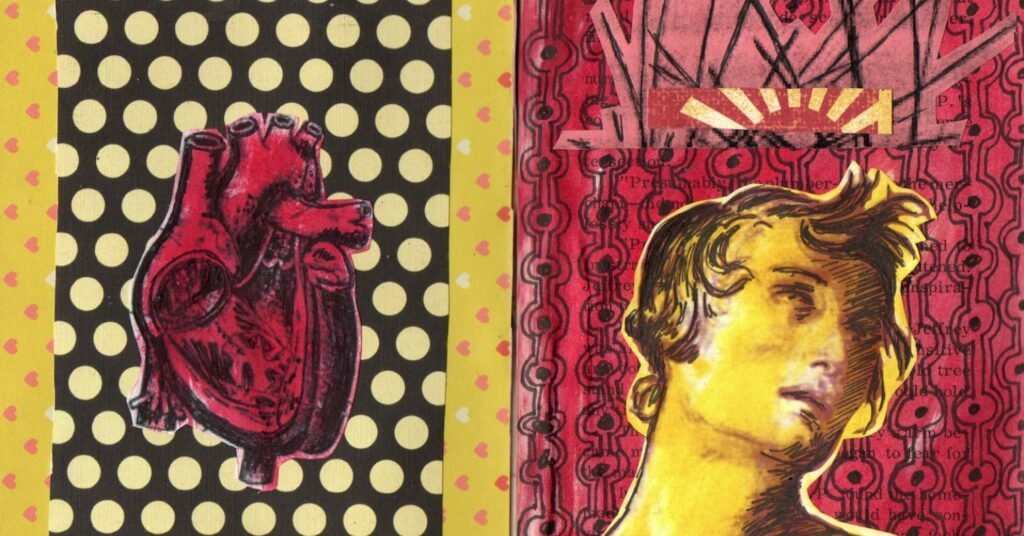
Source: ©2015 “Heart Beat” from the altered book of TBI, courtesy of Cathy Malchiodi, PhD
Over the last several decades, art therapists repeatedly note that art materials (pencils, pastels, clay, paint, collage and other media) elicit different emotional responses from art makers. For example, many observe that the more “fluid” the material, the more emotion may be expressed. However, most of the assumptions made about media have not been systematically tested or measured despite the popularity and proliferation of these statements in art therapy literature. Meanwhile, strategic applications of art materials, based on their sensory qualities, are a key part of art therapy intervention; therefore, any therapist using art media in psychotherapeutic approaches must understand the qualities of various materials in order to successfully engage individuals in the process of treatment.
A recently published study by Haiblum-Itskovitch, Czamanski-Cohen and Galili (2018) sought to explore art media by measuring the emotional and physiological responses to art making with different materials. In brief, these researchers set out to examine responses to art media through participants’ self-reports and through physiological measures. In particular, the researchers were interested in vagal activity as measured by heart rate variability (HRV) because of its impact on health-related outcomes. Many mental health practitioners are now familiar with the vagus nerve due to the pioneering work of Stephen Porges whose polyvagal theory explains human emotional and social reactions to interpersonal and environmental stimuli. The vagal nerve is the longest nerve in our autonomic nervous system (ANS) and is connected to functions throughout the body. Heart rate variability is relevant to vagal activity and indicative of ANS health in general. [For a more detailed explanation of polyvagal theory, please see Porges (2017).]
Sixty adults participated in a repeated measures experiment and each individual engaged in three 10-minute art making experiences (pencil, oil pastels and gouache paint) in a randomized order. A baseline level of arousal was established by having participants listen to five minutes of relaxing music of their choice (new age, nature sounds or classical) before each art making session. Post-sessions, participants reported their emotional reactions using a valid visual analog scale. In addition to the self-report instrument, researchers measured HRV of each participant through a wearable electrocardiogram device, calculating two indices—parasympathetic nervous system (PNS) and sympathetic nervous system (SNS).
This study’s findings give art therapists and those who use a variety of art media in psychotherapy a lot to think about when it comes to choosing materials. First, using gouache paint or oil pastels produced an improved positive mood; in contrast, pencil use did not. Additionally, data seem to indicate that the two branches of the ANS may have been influenced by art making with special media; in brief, the largest suppression of PNS (define) and augmentation of the SNS (define) occurred during the use of oil pastels and the researchers speculate that these findings may be related to unique emotional engagement due to the medium.
While this study yielded many interesting results, most art therapists will be interested in the data discovered through the inclusion of oil pastels in the study because the media has become somewhat ubiquitous in many art therapy sessions, particularly with adults. For the non-artist reader, oil pastels are like soft crayons that are easy to use and come in a variety of colors. They can be blended, are soft, and can be used to create texture and gestural marks on paper or canvas surfaces. In the field of art therapy, oil pastels have been associated with expression of emotion as well as control because they are generally easy to manipulate (Moon, 2010). In an earlier study, a significant number of participants indicated feelings of joy and excitement in anticipation of working with oil pastels (Snir & Regev, 2013). [For a nice overview of oil pastels, see the reference list for a downloadable document from Sakura (2018), a major producer of this medium.]
The researchers note that there are some limitations when interpreting the results of this study, including the number of participants, the method of participant recruitment and the presentation of art materials. Because of the lack of data on the impact of materials within the field of art therapy, they emphasize the need for additional research, particularly with different art media that present a variety of tactile and sensory qualities. Additionally, the participants were derived from a “normative” population; that is, they were more likely to have adaptive coping skills that influence their emotions and physiological responses.
The importance of the mind-body perspective within the theory and practice of art therapy has been a long time coming. Almost 20 years ago, I emphasized the role of mind-body medicine in the practice of art therapy, noting that, “Medicine, complementary therapies, and health psychology are beginning to explore how engaging in a creative process such as art making may actually produce positive physical changes in the body” (p. 18, 1999). Since that time, a few researchers have explored the role of biomarkers in measuring physiological responses to specific art making protocols (Malchiodi, 2014). This latest study underscores the importance of physiological measures in our rapidly increasing knowledge of just how art making impacts both body and mind and establishes a foundation for future research in this essential area of theory and practice.

